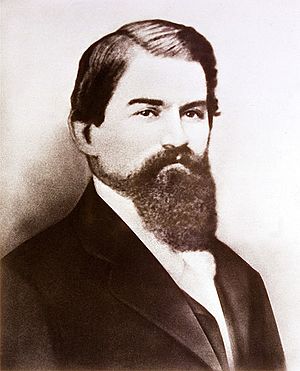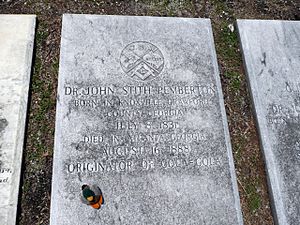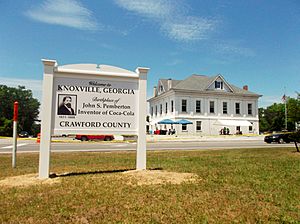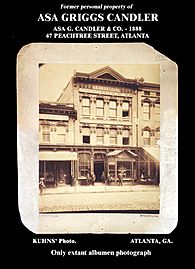John Stith Pemberton facts for kids
John Stith Pemberton (born July 8, 1831 – died August 16, 1888) was an American pharmacist. He is most famous for inventing Coca-Cola. In May 1886, he created an early version of the drink. However, he sold his rights to the recipe shortly before he passed away.
Pemberton was injured during a battle in April 1865. This led him to experiment with different remedies to help with pain. His search eventually led him to create the special recipe that later became Coca-Cola.
Quick facts for kids
John Pemberton
|
|
|---|---|

Pemberton, before 1888
|
|
| Born | July 8, 1831 Knoxville, Georgia, U.S.
|
| Died | August 16, 1888 (aged 57) Atlanta, Georgia, U.S.
|
| Resting place | Old City Cemetery |
| Education | Reform Medical College of Georgia |
| Occupation | Biochemist |
| Known for | Inventor of Coca-Cola |
| Spouse(s) | Ann Eliza Clifford Lewis |
| Children | Gerald Glenn Pemberton |
| Military career | |
| Service/ |
|
| Years of service | 1861–65 |
| Rank | |
| Unit | Third Cavalry Battalion of the Georgia State Guard |
| Battles/wars | American Civil War
|
Contents
Early Life and Education
John Pemberton was born on July 8, 1831, in Knoxville, Georgia. He spent most of his childhood growing up in Rome, Georgia. His parents were James C. Pemberton and Martha L. Gant.
Pemberton went to the Reform Medical College of Georgia in Macon, Georgia. In 1850, when he was nineteen, he earned his medical degree. His best skill was chemistry. After working a bit as a doctor and surgeon, Pemberton opened his own drug store in Columbus.
During the American Civil War, Pemberton served in the army. He was part of the Third Cavalry Battalion of the Georgia State Guard. He reached the rank of lieutenant colonel.
Family Life
John Pemberton met Ann Eliza Clifford Lewis in Columbus, Georgia. Her friends called her "Cliff." She had been a student at Wesleyan College. They got married in Columbus in 1853. Their only child, Charles Nay Pemberton, was born in 1854.
They lived in a Victorian style house in Columbus. This home, called the Pemberton House, is now a historic landmark. It was added to the National Register of Historic Places in 1971.
Creating Coca-Cola
In April 1865, Pemberton was injured during the Battle of Columbus. He began looking for new ways to help with pain.
Around 1866, he started trying out different pain remedies. He experimented with extracts from plants like the kola nut and damiana. He eventually created a recipe he called Pemberton's French Wine Coca.
This early drink was advertised as a good tonic, especially for people who felt tired or stressed.
In 1886, a new law was passed in Atlanta and Fulton County. This law meant that alcoholic drinks could no longer be sold. Because of this, Pemberton had to create a version of his French Wine Coca that did not contain alcohol.
He worked with Willis E. Venable, who owned a drugstore in Atlanta. Together, they tested and improved the recipe.
One day, Pemberton accidentally mixed his syrup with carbonated water. He liked the taste so much that he decided to sell it as a fountain drink instead of a medicine.
Frank Mason Robinson, Pemberton's bookkeeper, came up with the name "Coca-Cola." He thought the name sounded good and was easy to remember. The name comes from two main ingredients: coca leaves and kola nuts. Robinson also designed the famous swirly writing for the bottles and ads.
Pemberton claimed his new drink was a "valuable brain tonic." He said it could help with headaches, tiredness, and nerves. He also marketed it as "delicious, refreshing, pure joy, exhilarating," and "invigorating."
Selling the Business
Soon after Coca-Cola became available, Pemberton became very sick. He also ran into financial trouble. He started selling parts of his recipe rights to his business partners in Atlanta.
Pemberton believed his formula would "someday be a national drink." He wanted to keep some ownership for his son. However, his son needed money. So, in 1888, Pemberton and his son sold the rest of the patent. They sold it to another Atlanta pharmacist named Asa Griggs Candler. The price was US$1,750.
Death

John Pemberton died from stomach cancer in August 1888, at age 57. His body was taken back to Columbus, Georgia. He was buried at Linwood Cemetery. His grave marker has symbols showing his service in the army and his membership as a Freemason.
His son, Charley, continued to sell his father's formula for a few years. However, Charley died six years later.

Images for kids
See also
 In Spanish: John Stith Pemberton para niños
In Spanish: John Stith Pemberton para niños







